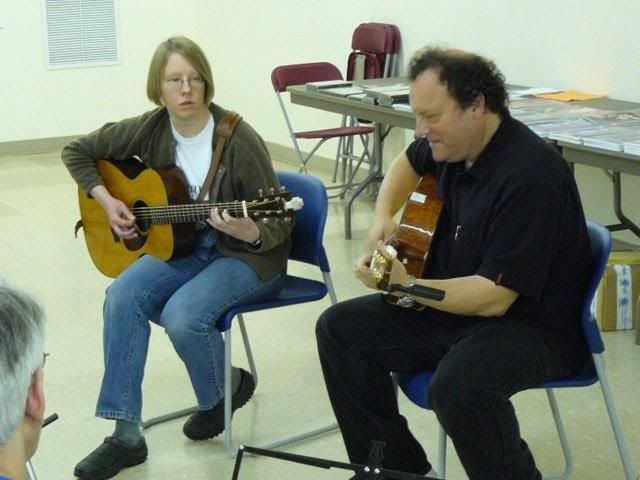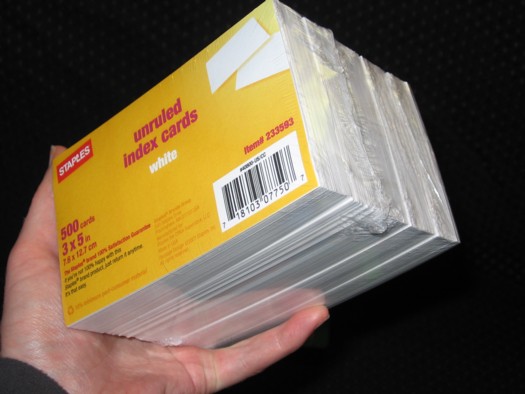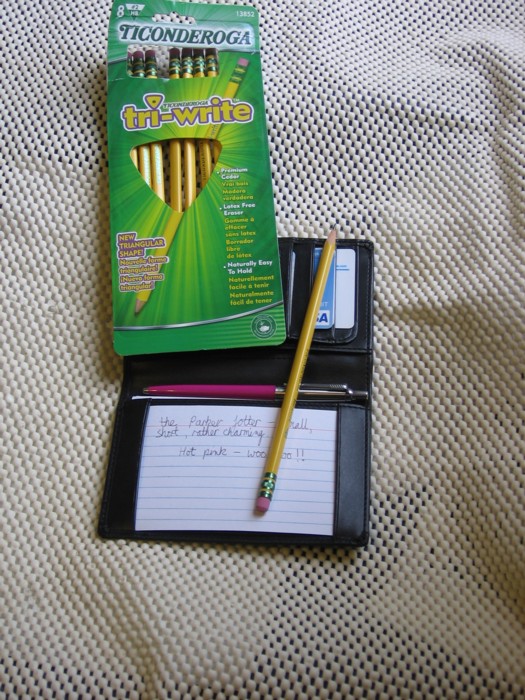Warning: I lazily cut and pasted this from a post I made to the FLATPICK-L guitar list, which means a high percentage of the content would likely only be of interest to fellow guitar nerds.
--BEGIN PASTED STUFF--
Steve Kaufman's workshops may just be the next best thing to his Kamp. And in his workshops, you get him for an entire day and a half, instead of just one class out of a week. (See other Kamp references on my blog here)
This particular workshop (pulled together by the Winlock Bluegrass Organization and Marv's Music) was held on April 24th and 25th, and was the first time I'd attended one of Steve's full workshops. I had high expectations, based on two trips to Kamp in 2001 and 2008, and such of his teaching materials as I've been able to accumulate. I wasn't disappointed. He's a masterful teacher, and a fun entertainer. More than that, one thing I've learned through workshops and Kamps is that although you can (and should!) learn something from every teacher and performer, now and again there will be one who speaks your language: someone whose methods just click for you, and turn on that little light bulb in your head. Not all of us will connect with the same people, of course--we learn in different ways and have different approaches to music. But Steve just makes sense to me.
The workshop was held at the old Yardbirds Mall in Chehalis, WA. I'd never been there before, but contrary to my usual method of operation, I found the place on my first try--it's kind of hard to miss the GIANT black bird sculpture out front. Too bad these can't always be used as landmarks for events--sure would make my life easier if I could just always look for ENORMOUS cartoon crows.
The mall used to be one of the biggest shopping centers in the area. These days, it's primarily an event center, with the downstairs portion taken up by lots of quirky little shops on one side and a grocery store on the other. We were upstairs, in a big room labeled "the Bird's Nest."
Since not everyone was able to make it to the evening session, and some people had had a long travel day, Steve kept Friday evening pretty laid back. He let us get all the gear questions out of the way, and showed off his beautiful red spruce / bubinga Ken Miller guitar. (Incidentally, bubinga is really fun to say. Bubinga, bubinga, bubinga!) He talked a bit about his too-thin yaller picks and why he likes them. He also had us write down some of the topics and tunes we wanted to work on the following day, showed us a little crosspicking and went over some rhythm techniques and bass runs.
Saturday was more intense. It started off with what he called the Saturday Morning Hot Seat. He went through the tunes we'd written down the day before, and for each tune, called up a victim...er...volunteer, and had them play it with him. Then we talked a bit about the tune. We covered Salt Creek, Bill Cheatham, Black Mountain Rag, St. Anne's Reel. Everyone did pretty good. Somewhere in the middle there I *almost* nodded when Steve said he'd go through Blackberry Blossom in a minute, which made me a volunteer. By the time Steve and another student were about halfway through St. Anne's Reel (Blackberry Blossom being next), I was already shaking and my hands were going clammy. But, hey, I told myself, I can do this. Blackberry Blossom is one of the tunes I've played and played and played with the Bluegrass Workout CDs. I was worried about flubbing the chords when my turn came to play backup, but I figured I could handle the melody. Then I actually got up there.
Aaand I was shaking so hard I could barely hit the strings, I blanked out on huge sections of the tune, I frantically hit random notes, and just generally made a mess of things until I finally just came to a crashing halt. And Steve made me play it again! Several times. The very last time through, I almost played the right notes in the B part. Yay me! But I was still shaking so hard my teeth were practically chattering. I can't say my performance was a resounding success. At the least, though, maybe some of the other students who were nervous about getting up there can think, "Well, at least I could do better than *that*...."

Me in the hot seat: note my deer-in-the-headlights expression.
As I walked back to my seat, Steve said, "Now, you do that again next chance you get! That's how you get over performance anxiety!" Oh, goody! My poor bruised ego was screaming, "Do it again? Are you kidding?? Don't you *dare* do that to me again!" But I reckon I'm fool enough to try.
Over the course of the rest of the day, we learned Mississippi Sawyer and did some crosspicking. Steve pulled a sneaky one on us, though: he taught us a seemingly random little progression and had us work on it piece by piece for a good portion of the afternoon. Then he put it all together and, like magic, there was a crosspicked arrangement of the first part of Wildwood Flower.
Interspersed between it all, Steve dispensed wisdom on allocation of practice time, getting volume and power out of your playing, and why it's important to work on your down-ups. I want to work on his wide swing attack--my volume needs all the help it can get. And I know pick direction is one of the biggest reasons I have points in tunes where I get mixed up: it would behoove me to slow down and really concentrate on the down-ups for awhile. He also talked about the importance of repetition when learning tunes, which was something I needed to hear. I love pretty tunes, and I'm able to toddle off after more and more pretty tunes without really learning the ones I already have.
After the workshop, there was a bit of jamming, and later in the evening, Steve's concert down at the Hub City Cafe in Centralia, WA. (I got lost on the way there. See above about ENORMOUS cartoon crows. I'm tellin' ya...it'd really help me out!) Marv's band, the Black River Band opened, and did a fine job. I especially liked their rendition of "The Water is Wide," and Joan Smith's original song at the end of their set. Then Steve came out and started out by tearing it up on a fiddle tune medley segueing into some fingerpicking. Good stuff. The whole set was good. I think my favorites were the waltzes, just because I'm a sucker for waltzes--he did a really pretty harmonics bit at the end of Festival Waltz, and Ookpik is an old favorite of mine. He ended it off with a medley that started with Over the Waterfall--another favorite of mine.
All in all, a great time! Kind of a little taste of Kamp.












